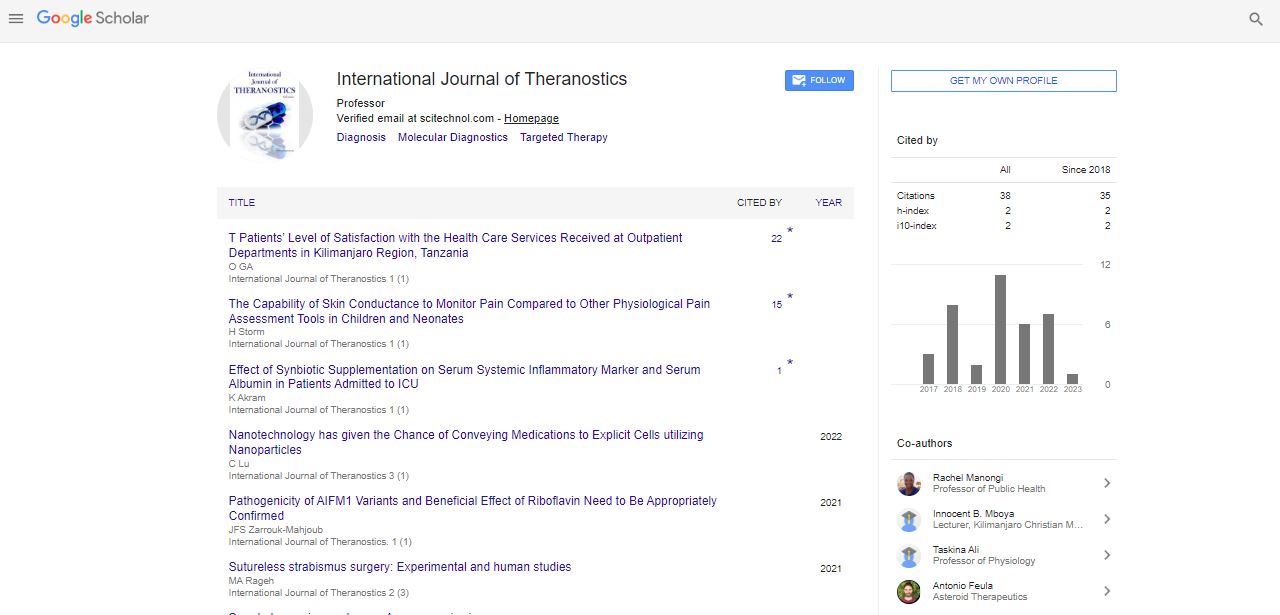Commentary, Int J Theranostic Vol: 12 Issue: 4
Multimodal Imaging Agents: Pioneering Comprehensive Diagnosis and Therapeutic Monitoring
Ahmet Shah*
1International School of Medicine, Istanbul Medipol University, Istanbul, Turkey
*Corresponding Author: Ahmet Shah,
International School of Medicine, Istanbul
Medipol University, Istanbul, Turkey
E-mail: shahahmet@gmail.com
Received date: 27 November, 2023, Manuscript No. IJT-23-124057;
Editor assigned date: 29 November, 2023, PreQC No. IJT-23-124057 (PQ);
Reviewed date: 14 December, 2023, QC No. IJT-23-124057;
Revised date: 21 December, 2023, Manuscript No. IJT-23-124057 (R);
Published date: 28 December, 2023, DOI: 10.4172/IJT.1000144.
Citation: Shah A (2023) Multimodal Imaging Agents: Pioneering Comprehensive Diagnosis and Therapeutic Monitoring. Int J Theranostic 12:5.
Description
Imaging technologies play a pivotal role in modern healthcare, providing clinicians with valuable insights into the intricacies of diseases and treatment responses. The advent of multimodal imaging agents has revolutionized diagnostic and monitoring approaches by combining the strengths of different imaging modalities. This essay delves into the design and application of imaging agents that enable multiple imaging modalities, offering a comprehensive view for accurate diagnosis and monitoring of therapeutic responses.
Traditional imaging techniques, such as X-ray, Computed Tomography (CT), Magnetic Resonance Imaging (MRI), and Positron Emission Tomography (PET), each have unique strengths and limitations. X-rays excel at visualizing bone structures, while MRI offers exceptional soft tissue contrast. PET provides functional information about metabolic activity, and CT offers high-resolution anatomical images. However, relying on a single imaging modality may limit the ability to capture the full complexity of a disease or assess treatment responses comprehensively.
Multimodal imaging addresses this limitation by integrating complementary modalities into a single imaging agent. These agents can simultaneously provide anatomical, functional, and molecular information, enhancing the diagnostic accuracy and allowing for a more nuanced understanding of disease progression and therapeutic effects.
The core structure of a multimodal imaging agent serves as the foundation for its versatility. Nanoparticles, such as quantum dots or liposomes, are common choices due to their size, tunable properties, and potential for surface modifications. The choice of core material influences the agent's imaging capabilities and biocompatibility.
Surface functionalization involves modifying the imaging agent with ligands or molecules that confer specific properties. Targeting ligands, such as antibodies or peptides, enable the agent to selectively bind to disease-specific markers, improving its specificity. Additionally, functionalization with contrast agents enhances imaging capabilities, allowing for improved visualization in various modalities.
For optical imaging, fluorophores or bioluminescent molecules are incorporated into the imaging agent. These components emit light when excited, facilitating high-resolution imaging. Quantum dots, with their unique optical properties, are particularly advantageous in providing both fluorescence and photoacoustic signals. Nuclear imaging relies on the detection of gamma rays emitted by radioisotopes. Incorporating suitable radioisotopes, such as technetium-99m or fluorine-18, enables the imaging agent to be used in PET or SPECT scans. This allows for quantitative assessment of molecular processes and metabolic activities in vivo.
Magnetic resonance imaging benefits from the inclusion of paramagnetic or superparamagnetic components. Gadolinium-based contrast agents or iron oxide nanoparticles can enhance the contrast in MRI images, providing detailed anatomical information with high spatial resolution.
Microbubbles or nanodroplets filled with gas can serve as ultrasound contrast agents. When exposed to ultrasound waves, these agents produce echoes that enhance the ultrasound image. Integrating these agents into a multimodal platform allows for the fusion of ultrasound imaging with other modalities.
Multimodal imaging agents have shown significant promise in cancer diagnosis. Combining optical imaging with nuclear imaging or MRI enables both anatomical visualization and functional assessment of tumors. Targeted agents can be designed to specifically accumulate in cancerous tissues, allowing for precise localization and characterization.
In neuroimaging, multimodal agents offer a comprehensive approach to studying neurological disorders. For example, combining MRI with PET allows for the simultaneous assessment of structural abnormalities and changes in neurochemistry. This is particularly valuable in conditions such as Alzheimer's disease, where both anatomical and functional information are crucial for accurate diagnosis.
Multimodal agents enhance cardiovascular imaging by combining anatomical data from CT or MRI with functional information from nuclear imaging. This comprehensive approach is valuable in assessing cardiac perfusion, function, and potential abnormalities, providing a more holistic view of cardiovascular health. Multimodal imaging agents play a pivotal role in monitoring responses to cancer therapies. For instance, changes in tumor metabolism, perfusion, and size can be simultaneously evaluated using PET, MRI, and CT, respectively. This multimodal approach aids in the early detection of treatment efficacy or potential resistance.
Nanoparticle-based multimodal agents can be designed to carry therapeutic payloads in addition to imaging components. This allows for the tracking of drug delivery to specific tissues or cells. Monitoring drug distribution and release in real-time facilitates the optimization of therapeutic regimens and minimizes off-target effects.
Multimodal imaging is instrumental in assessing inflammatory processes and immune responses. Agents designed to target specific immune cells or inflammatory markers can be visualized using a combination of optical, nuclear, and MRI imaging. This is particularly relevant in autoimmune disorders and immunotherapy monitoring.
Ensuring the biocompatibility and safety of multimodal imaging agents is a critical consideration. The potential toxicity of certain components, especially inorganic nanoparticles, must be thoroughly evaluated to minimize adverse effects.
Integrating multimodal imaging into routine clinical practice requires standardization of protocols, imaging systems, and data interpretation. Achieving consensus on standardized approaches will facilitate broader acceptance and implementation of multimodal imaging techniques. Bridging the gap between preclinical success and clinical translation remains a challenge. Rigorous validation studies, regulatory approvals, and large-scale clinical trials are essential to demonstrate the safety and efficacy of multimodal imaging agents in diverse patient populations.
 Spanish
Spanish  Chinese
Chinese  Russian
Russian  German
German  French
French  Japanese
Japanese  Portuguese
Portuguese  Hindi
Hindi 